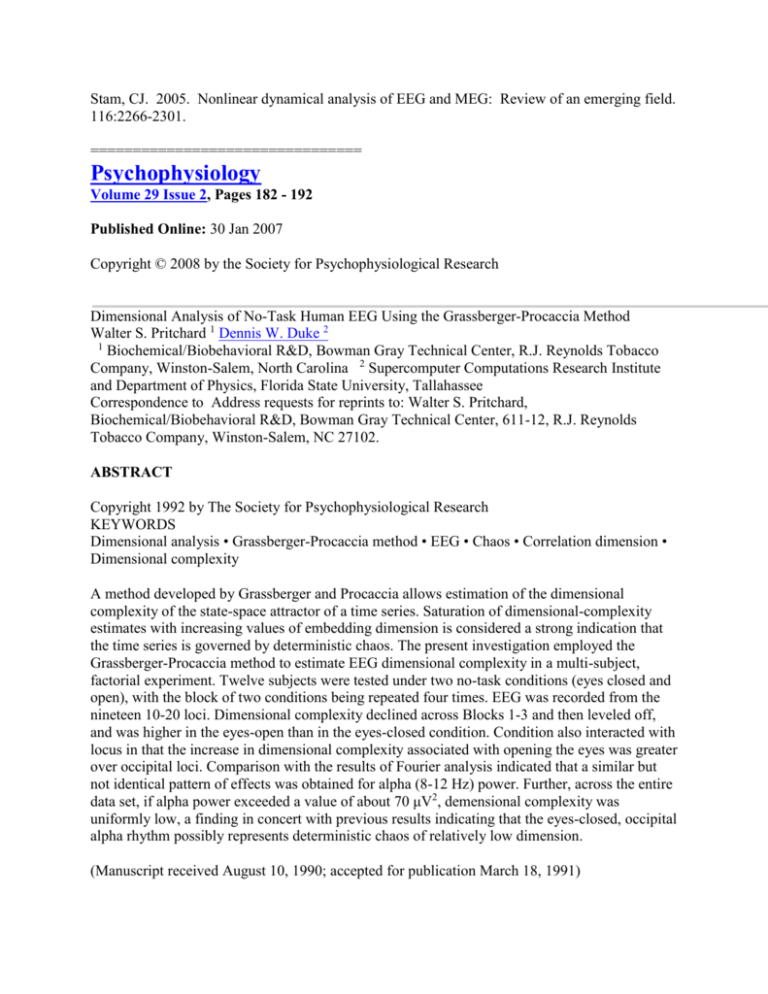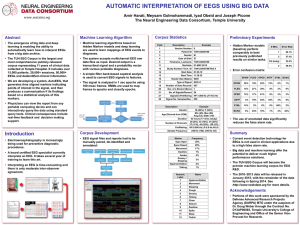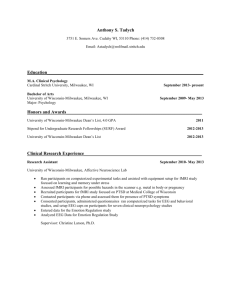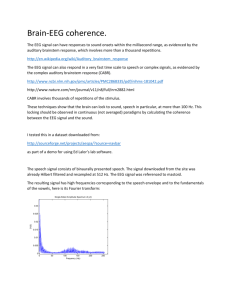Important References
advertisement

Stam, CJ. 2005. Nonlinear dynamical analysis of EEG and MEG: Review of an emerging field. 116:2266-2301. ================================ Psychophysiology Volume 29 Issue 2, Pages 182 - 192 Published Online: 30 Jan 2007 Copyright © 2008 by the Society for Psychophysiological Research Dimensional Analysis of No-Task Human EEG Using the Grassberger-Procaccia Method Walter S. Pritchard 1 Dennis W. Duke 2 1 Biochemical/Biobehavioral R&D, Bowman Gray Technical Center, R.J. Reynolds Tobacco Company, Winston-Salem, North Carolina 2 Supercomputer Computations Research Institute and Department of Physics, Florida State University, Tallahassee Correspondence to Address requests for reprints to: Walter S. Pritchard, Biochemical/Biobehavioral R&D, Bowman Gray Technical Center, 611-12, R.J. Reynolds Tobacco Company, Winston-Salem, NC 27102. ABSTRACT Copyright 1992 by The Society for Psychophysiological Research KEYWORDS Dimensional analysis • Grassberger-Procaccia method • EEG • Chaos • Correlation dimension • Dimensional complexity A method developed by Grassberger and Procaccia allows estimation of the dimensional complexity of the state-space attractor of a time series. Saturation of dimensional-complexity estimates with increasing values of embedding dimension is considered a strong indication that the time series is governed by deterministic chaos. The present investigation employed the Grassberger-Procaccia method to estimate EEG dimensional complexity in a multi-subject, factorial experiment. Twelve subjects were tested under two no-task conditions (eyes closed and open), with the block of two conditions being repeated four times. EEG was recorded from the nineteen 10-20 loci. Dimensional complexity declined across Blocks 1-3 and then leveled off, and was higher in the eyes-open than in the eyes-closed condition. Condition also interacted with locus in that the increase in dimensional complexity associated with opening the eyes was greater over occipital loci. Comparison with the results of Fourier analysis indicated that a similar but not identical pattern of effects was obtained for alpha (8-12 Hz) power. Further, across the entire data set, if alpha power exceeded a value of about 70 μV2, demensional complexity was uniformly low, a finding in concert with previous results indicating that the eyes-closed, occipital alpha rhythm possibly represents deterministic chaos of relatively low dimension. (Manuscript received August 10, 1990; accepted for publication March 18, 1991) Titre du document / Document title Why bother to spatially embed eeg ? Comments on Pritchard et al., psychophysiology, 33, 362368, 1996. Auteur(s) / Author(s) PEZARD L. (1 2) ; LACHAUX J.-P. (1) ; THOMASSON N. (1) ; MARTINERIE J. (1) ; PRITCHARD W. S. (Auteur de la réponse) (3 4 5) ; Résumé / Abstract In a recent paper, Pritchard, Krieble, and Duke (Psychophysiology, 33, 362-368, 1996) studied the validity of spatial embedding of electroencephalographic (EEG) data and rejected this method in favor of time-delay embedding. The present paper describes the nonlinear characterization of brain dynamics using either spatial or time-delay embedding. We discuss the arguments published in Pritchard et al. (1996) and demonstrate that the spatial embedding cannot be rejected on this basis. We also point out the limitations of both spatial and time-delay embeddings related to the spatial extension and the high-dimensional dynamics of brain activity. Revue / Journal Title Psychophysiology ISSN 0048-5772 CODEN PSPHAF Source / Source 1999, vol. 36, no4, pp. 527-535 (dissem.) ========================================== Chae , J . Jeong , B . Peterson , D . Kim , W . Bahk , T . Jun , S . Kim , K . Kim Dimensional complexity of the EEG in patients with posttraumatic stress disorder . Psychiatry Research: Neuroimaging , Volume 131 , Issue 1 , Pages 79 - 89 J . Abstract Recent electrophysiological studies have reported evidence of information processing abnormalities in patients with posttraumatic stress disorder (PTSD). The aim of this study is to examine dynamical complexity of the EEG in PTSD patients, which is thought to reflect information processing of the brain. Resting EEG recordings (32800 data points acquired continuously from 82 s of an EEG record) were obtained in 16 channels of 27 patients with PTSD from a mixed civilian trauma population and 14 healthy subjects. The correlation dimension (D2) of the EEG was used to quantify the complexity of the cortical dynamics underlying the EEG signal. The PTSD patients were found to have lower D2 values than those of the healthy subjects in most channels (Fp1, F8, C4, P4, T3, T4, T5, T6, and O1), indicating that PTSD patients have globally reduced complexity in their EEG waveforms. This study supports the hypotheses that PTSD patients exhibit disturbed cortical information processing, and that non-linear dynamical analysis of the EEG can be a tool for detecting changes in neurodynamics of the brain in PTSD. Fell et al. (1996) – 2-dimensional space for D2 calculation Takens (1981) – 10-dimensional space for Lyapunov exponent calculation Woyshville et al. (1994) – computing fractal dimension Chaos Data Analyzer Software Pro (Sprott & Rowlands, 1995) Also, with respect to bispectral analysis: ================================== Does bispectral analysis of the electroencephalogram add anything but complexity? MILLER A. (1) ; SLEIGH J. W. (1) ; BARNARD J. (1) ; STEYN-ROSS D. A. (1) ; (1) Department of Anaesthesia, Waikato Hospital, Hamilton, NOUVELLE-ZELANDE British Journal of Anaesthesia 2004, vol. 92, no1, pp. 8-13 Abstract Background. Analysis of the bispectrum of EEG waveforms is a component of the proprietary BIS index-a commonly used commercial monitor of depth of anaesthesia. Does the use of the bispectrum give more information about depth of anaesthesia than the power spectrum? Methods. We collected and analysed EEG waveforms during induction of general anaesthesia in 39 patients, comparing the changes in bispectral parameter (SynchFastSlow), with an analogous power spectrum-based parameter (PowerFastSlow). Both compare the logarithmic ratio of high frequency components (40-47 Hz) with the total (I-47 Hz). Because the changes in bispectrum are affected by signal amplitude, we also calculated a third parameter (SFSbicoh) from the bicoherence, which is an amplitude-independent statistic. Results. The SynchFastSlow and PowerFastSlow were correlated (r=0.84) and neither was superior in predicting the awake or anaesthetized state (area under receiver operating characteristic curves = 0.85 vs 0.93). There was no change in the SFSbicoh over the induction period, and it did not correlate with SynchFastSlow (r=0.07). Conclusions. We could not show that bispectral analysis gave more information than power spectral-based analysis. Most of the changes in the bispectral values result from decreases in the relative high frequency content of the EEG caused by anaesthesia. ==================================






